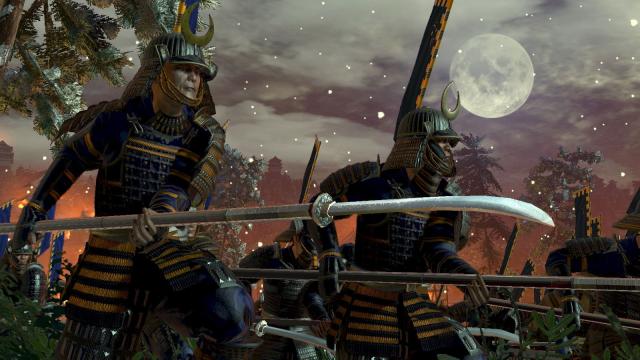While easily its most ambitious title to date, 2009’s Empire: Total War was also a rather divisive game for fans of Creative Assembly’s classic strategy series. Total War: Shogun 2 feels like a direct response to that.
The game puts you in command of one of the various Warlords from 16th century Japan, a time of upheaval for the island nation that saw families and factions vying for control and the blessing of the Emperor to assume the title of Shogun. It’s the seventh Total War game to have been released since 2003, and for those coming back to the series after the pomp and gunfire of Empire and Napoleon, it marks a distinct return to the roots of one of PC gaming’s most storied franchises.
Why You Should Care

Empire: Total War was a magnificent game, but it was also polarising, its scale wowing some while its lack of personality and crippling bugs were too much for others. Shogun goes to great lengths to address those complaints, scaling back the game’s scope on the strategic level while tricking out almost every other aspect of the game.
What We Liked
Warm & Fuzzy: Both Empire & Napoleon felt cold. Distant. Like you were playing a board game. Shogun 2 takes the opposite route, dunking you up to your eyeballs in the sights and sounds of 16th-century Japan. From the artwork on loading screens to the cherry blossoms blowing in the breeze on the campaign map to the relaxing sounds of the shakuhachi, for the duration of your experience you’ll be transported back in time. There’s a level of immersion to it all that no other historical strategy game I’ve ever played can match.
Learning: No war game will ever have perfect AI. But Shogun’s is at least a marked improvement over Empire & Napoleon, on both the battlefield and the strategic map. Computer-controlled armies now march as one on the battlefield, and will actively seek the best terrain on the map. Other factions now behave less like lunatics, more eager to nurture alliances and establish trade routes than stab you in the face every five turns.
Role-Playing: The Total War series has always had a role-playing element to it, but Shogun turns this all the way up to eleven, allowing you to directly assign skill points unlocked in battle to each commander. This not only lets you tailor each General’s abilities to suit your style of play, but means you grow very fond of them as your campaign progresses and they become more personalised and more powerful.
It Works: I’m touching wood while I type this, but Shogun has so far suffered from none of the technical disasters that so marred Empire and, to a lesser extent, Napoleon. The AI’s campaign turns don’t take an age to complete, nor do they cause hangs or lock-ups, while I haven’t encountered a single other error in the game, whether that be a graphical glitch or a system error.
A Purpose: The game’s multiplayer has a couple of nice new additions. The first, and most important, is your persistent online avatar, an in-game representation of you that levels up the more you play and the more you win. This little guy ties you to the battlefield in a way the disposable multiplayer battles of old could not. The other is the inclusion of strategic points on the map. Remember how you could occupy buildings in older games but it never really did anything? It does now, as buildings will be scattered across multiplayer battle maps granting bonuses to the army controlling them. This presents a great focal point for the battles, giving you something to fight over.
Mission Complete: There’s never really been a point to Total War games before. You build up armies, take more land, and…that’s it. Shogun 2 gives the game a great sense of purpose by tasking the player with capturing the ancient capital of Kyoto and holding it for four turns. This means players can approach the game from a number of ways: you can steamroll across the map like the days of old, or you can be more precise, biding your time and building up your forces for a sudden and clinical strike on the capital.
What We Didn’t Like
Scaled Back: The benefits of scaling back the scope of the last few Total War games have been listed above. The downside, though, is that you’ll quickly see all the game has to offer, as a smaller map with less units available means there’s less scope for replayability as with Empire’s sprawling globe.
Nobody’s Home: Like I said above, most of the AI kinks have been ironed out from previous games. But not all. One that interrupts the experience from time to time is the fact the AI rarely bothers to actually defend his regions. They’ll swoop in, take a city, then promptly move on, leaving you free to retake it without a fight. Sometimes this has you caught in a wild goose chase as you follow an enemy army around the map retaking the cities he doesn’t defend, but thankfully in two full campaigns this has only happened 4-5 times.
The Bottom Line
They say you can never go home again. Well, with Shogun 2 Creative Assembly has done just that. Shogun 2 may be re-treading familiar ground, but it’s doing so with a range of features and innovations both new and repaired that make this the most polished, focused and enjoyable Total War game to date.
Total War: Shogun 2 was developed by Creative Assembly and published by Sega for the PC. Released on March 15, 2011. Retails for $US50. A copy of the game was given to us by the publisher for reviewing purposes. Completed two campaigns, one on normal, one on hard. Unable to test general multiplayer.

Leave a Reply